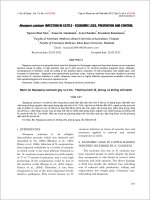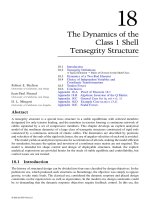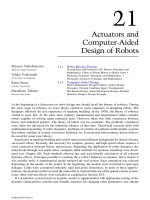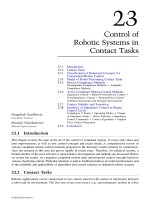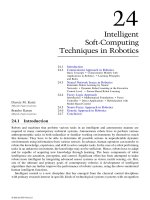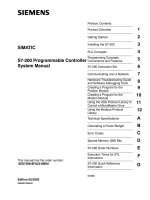- Trang chủ >>
- Khoa Học Tự Nhiên >>
- Vật lý
How maps restrict and control
Bạn đang xem bản rút gọn của tài liệu. Xem và tải ngay bản đầy đủ của tài liệu tại đây (3.81 MB, 258 trang )
NO DIG, NO FLY, NO GO
HOW MAPS
RESTRICT
AND CON T ROL
Mark
Monmonier
the univ ersit y of chic ag o pr e ss
Chicago and London
mar k monmonier is distinguished professor of
geography at Syracuse University’s Maxwell School of
Citizenship and Public Affairs.
The University of Chicago Press, Chicago 60637
The University of Chicago Press, Ltd., London
© 2010 by Mark Monmonier
All rights reserved. Published 2010
Printed in the United States of America
19 18 17 16 15 14 13 12 11 10
1 2 3 4 5
isbn-13: 978-0-226-53467-1 (cloth)
isbn-10: 0-226-53467-7 (cloth)
isbn-13: 978-0-226-53468-8 (paper)
isbn-10: 0-226-53468-5 (paper)
Library of Congress Cataloging-in-Publication Data
Monmonier, Mark S.
No dig, no fly, no go : how maps restrict and control /
Mark Monmonier.
p. cm.
Includes bibliographical references and index.
isbn-13: 978-0-226-53467-1 (cloth : alk. paper)
isbn-10: 0-226-53467-7 (cloth : alk. paper)
isbn-13: 978-0-226-53468-8 (pbk. : alk. paper)
isbn-10: 0-226-53468-5 (pbk. : alk. paper)
1. Cartography—Social aspects. 2. Maps—Social aspects.
3. Cartography—Economic aspects. 4. Maps—Economic
aspects. 5. Cartography—Political aspects. 6. Maps—
Political aspects. I. Title.
ga108.7.m664 2010
303.3—dc22
2009033338
o The paper used in this publication meets the minimum
requirements of the American National Standard for
Information Sciences—Permanence of Paper for Printed
Library Materials, ansi z39.48-1992.
i n m e mory of v ir g i n i a
and jack eisenhar dt
The General explained to them clearly and briefly
the object of his visit among them, and, if they were
willing to comply with his demands, the white and
red man could once more be at peace. The country
below Pease creek was shown to them upon the map,
the boundary defined, and if they were disposed to
go there and be at peace, and not cross the line, they
should remain unmolested for the time being.
“Affairs in Florida,” The New-Yorker, June 22, 1839
A redrawn zoning plan for Troy . . . would allow
residents to keep three dogs or cats, an increase from
the current maximum of two, Davis said. . . . “We felt
that in a lot of cases people might have three indoor
cats. We didn’t want to deem them to be criminals.”
Zoning violations can cost a homeowner $100 a day
until they are corrected.
Dayton (Ohio) Daily News, September 7, 1999
CONTENTS
Preface and Acknowledgments xi
Introduction: Boundaries Matter 1
Keep Off ! 6
Keep Out! 30
Absentee Landlords 51
Dividing the Sea 70
Divide and Govern 86
Contorted Boundaries, Wasted Votes 104
Redlining and Greenlining 117
Growth Management 130
Vice Squad 146
No Dig, No Fly, No Go 160
Electronic Boundaries 180
Notes 189
Selected Readings for Further Exploration
Sources of Illustrations 223
Index 229
217
P R E FA C E
AND
ACKNOWLEDGMENTS
Map history can be sliced and diced in diverse ways. To cope with the
challenges of language and culture as well as the field’s enormous richness, writers typically concentrate on a particular period and country, say,
eighteenth-century France. They might also focus on a specific person or
problem—Dava Sobel did both in Longitude, the saga of John Harrison’s
heroic effort to perfect a cartographically precise timepiece—or examine
a particular map or type of map, for example, the infamous Vinland Map
or the maps of exploration and discovery more generally. As an examination of the rise and pervasiveness of what I call prohibitive cartography, No
Dig, No Fly, No Go reflects the latter approach, but with necessarily varied
examples because the story of the restrictive map leads in many directions.
I look mostly at twentieth-century North America because that’s where
much of the development occurred—I say “mostly” and “much” because
insightful examples from other regions are unavoidable and roughly parallel developments on other continents are readily apparent. Although a
more complete book might justify a decade of additional research, I’m
convinced I’ve captured the essence of prohibitive mapping because cartography worldwide started becoming significantly more homogenized
since the middle of the nineteenth century. France and The Netherlands,
pr efac e and ac know ledgment s · xi
for instance, are far less cartographically distinct nowadays than several
centuries ago.
Insofar as prohibitive cartography works by placing boundary lines on
maps, No Dig, No Fly, No Go is the latest installment in my series of short
integrative cartographic histories that explore the evolution and impact of
an important symbol or map feature. The initial volume was Rhumb Lines
and Map Wars: A Social History of the Mercator Projection (2004), which focuses on the innovative and occasionally controversial grid lines that frame
world maps. In a similar vein, From Squaw Tit to Whorehouse Meadow:
How Maps Name, Claim, and Inflame (2006) delves into the arcane world of
standardized place and feature names, while Coast Lines: How Mapmakers
Frame the World and Chart Environmental Change (2008) is summed up
pretty well by its title and subtitle.
My original plan was to write a narrower sequel to How to Lie with
Maps (1991, 1996), which is a comparatively abstract and timeless exploration of the inevitability and the consequences of map generalization.
Although No Dig, No Fly, No Go also recognizes the map as a powerful
tool of persuasion, the earlier book’s heavy reliance on simple hypothetical examples wouldn’t work here, largely because deliberate deception or
unwitting self-deception is less important to prohibitive cartography than
social acquiescence—our unconscious acceptance of cartographic boundaries of all types as natural, beneficial, and worth obeying. To comprehend
the rise and broad implications of prohibitive cartography, it’s necessary to
examine a widely representative range of real maps.
To avoid leading the reader on distracting forays into abstract treatments of power and territory, I focus on showing how prohibitive cartography works as a mapping tool and largely avoid the secondary academic
literature. Readers eager for additional information should benefit from
the selected readings listed by chapter toward the back of the book.
Because prohibitive cartography is truly pervasive, identifying relevant
examples was easier than finding truly insightful exemplars that work well
on a small page in black-and-white. I am particularly indebted to Cathy
Kittle and Jeremy Hurst at the New York State Department of Environmental Conservation; John Olson and Elizabeth Wallace, respectively the
geographic information and earth science librarians at Syracuse University; John Long at the Newberry Library, in Chicago; and Jolai Jenkins,
in the mayor’s office at Tuskegee, Alabama. Terry Simmons and Karen
Culcasi provided useful leads, and George Demko and Lee Schwartz
xii · pr efac e and ac know ledgment s
helped nail down the details of travel restrictions on Soviet diplomats and
journalists. Joe Stoll, staff cartographer at Syracuse University’s department of geography, was a valuable ally in sussing out the complexities of
Adobe Photoshop, and the Information and Computing Technology staff
at SU’s Maxwell School, especially Brian von Knoblauch, Stan Ziemba,
Mike Fiorentino, and Ed Godwin, provided rapid response to issues of
file storage, network access, and Vista. For broader moral support I am
indebted to my colleagues on the History of Cartography Project, particularly Matthew Edney, Mary Pedley, Jude Leimer, and Beth Freundlich. Judy Tyner and Susan Schulten provided helful comments on the
penultimate draft. Thank you, too, to Christie Henry, Dmitri Sandbeck,
Mark Reschke, Stephanie Hlywak, and Isaac Tobin for the ever reassuring
imprint of Chicago style.
pr efac e and ac know ledgment s · xiii
CHAPTER
ONE
INTRODUCTION
BOUNDARIES
MAT TER
Maps exert power in two ways: by shaping public opinion and by telling us
where we can’t go and what we can’t (or must) do in specific places. This
book examines the second type, which I call imperative maps because of
their similarity to imperative sentences—the bossy ones that often end in
an exclamation point. Whether blatant or subtle, the imperative map is
usually intended either to stifle movement or to restrict an activity with
a spatial dimension. Examples include aeronautical charts with “no-fly”
zones, world political maps, and municipal zoning maps, backed up, respectively, by military aircraft, border guards, and code enforcement officers. The genre also embraces floodplain and fault-zone maps, enforced
jointly by environmental agencies and Mother Nature. Whether the penalty for defiance is explicit or implied, an imperative map is a geographic
threat that warns of unpleasant consequences. Not surprisingly, most restrictive maps are blatantly prohibitive.
Prohibitive cartography emerged as a distinct dimension of map use
sometime after 1900, when restrictive maps increased markedly in variety, pervasiveness, and impact to reflect the growing complexity of cities,
governments, and corporations. Although this intensification has roots in
Roman property maps, partly intended to thwart trespass, any map with
i n t r od uc t ion · 1
boundary lines delineating a territory as small as a farm or building lot,
or as large as a nation-state, is fundamentally a restrictive map. Longstanding public acceptance of property maps and other boundary maps
quite likely underlies an expectation by government officials that a wider,
more intensive use of prohibitive maps would be understood and accepted.
Prohibitive elements are now apparent in most cartographic modes and
institutional practices.
Factors underlying this expansion include advances in transportation
technology and public administration as well as an increased wariness
of urban growth and hazardous environments. While maps portraying
historic districts and marine protected areas are necessarily prohibitive,
nautical charts and many recreation maps include restrictive elements
but largely address other, more important concerns. And even the comparatively nonauthoritarian topographic map shows municipal and state
boundaries, which can separate marked differences in tax policy, criminal
codes, zoning laws, and environmental regulations.
Perhaps the quintessential prohibitive map is the aeronautical chart,
which defines and regulates navigable airspace. Complex and often
ephemeral restrictions embedded in contemporary aeronautical charts reflect a historically significant transition from the map as a tool for exploration, discovery, and navigation to the map as a comparatively complex
instrument with roles that include public safety, growth management, and
environmental protection. Among the diverse roles of prohibitive cartography, the no-fly zone has become a tool of humanitarian intervention, and
map-based regulations are indispensable in wildlife conservation
Prohibitive cartography has its own graphic rhetoric. Because efficient
enforcement depends on well-defined territorial restrictions, the primary
symbol on most prohibitive maps is the boundary line, underscored perhaps by labels and contrasting colors. By convention, small-scale political
maps printed in color rely heavily on dissimilar hues—when France is
green and Germany is purple, there’s less need for the prominent dot-anddashed “international boundary” symbol common on graytone maps. The
mapmaker can emphasize national sovereignty with thick, solid black
lines—the most prominent symbol on many State Department maps—or
underscore disputed or otherwise tentative boundaries with equally thick
dashed lines. By contrast, the thinner, less prominent dot-and-dashed line
is a convenient, readily understood code useful with less strident atlas maps,
on which political boundaries have a weaker claim to continuity than roads,
2 · chap t er on e
railways, and rivers. By chance, line symbols with periodic gaps afford a
more accurate representation of boundaries like the U.S.-Mexico border,
which is far more permeable than an unbroken line might suggest.
Just because a boundary is mapped is no reason to assume it’s accepted
by the neighbors it separates or by the world at large. Indeed, of all features
shown on maps, boundaries are by far the most contentious. While most
boundaries signify peaceful sovereignty or undisputed ownership, more
than a few assault national pride or personal dignity, often with tragic
results. Aggrieved nations declare war, feuding neighbors go to court, and
parents upset over reconfigured school attendance zones elect a new school
board or pick up and move. Any sudden, unexplained change to a mapped
boundary can incite spontaneous resistance, and festering resentment of
an old boundary can evoke a forceful reaction.
No less controversial are boundaries tied to zoning ordinances and
wetlands regulations. In much the same way that lot lines confirm a property right to sell land and exclude trespassers, boundaries that restrict the
owner’s use of a parcel transfer some of that property right to the public
at large. Imposing these restrictions can be enthusiastically embraced as
responsible government or vigorously condemned as an “unconstitutional
taking.”
Boundary maps have a rich history, with ancient roots and a modern
resurgence. Some of the earliest maps no doubt portrayed property boundaries, but the cartographic record here is spotty at best. Because primitive drawings rarely survived, archaeologists can only assume that ancient
Egyptians diagrammed the painstaking measurements used to reestablish
boundaries after the Nile’s annual inundation. Historians trace the modern property map to the Roman Empire, where boundary stones were
altars to Terminus, the god of boundaries, and anyone who destroyed or
moved one was subject to death or a large fine. Roads, aqueducts, and other
engineering works required maps, to be sure, and Roman town plans described the layout of streets and structures. By contrast, national frontiers
were comparatively vague and mapped largely by military commanders,
whose topographic maps focused on rivers, mountains, settlements, forts,
bridges, and roads. National boundaries gained prominence much later, in
sixteenth-century atlases, in which recorded borders reinforced notions of
national identity, but imperative maps were not a coherent cartographic
genre until the twentieth century.
Boundary lore includes fascinating tales of ignorance and greed. It
i n t r od uc t ion · 3
also affords an opportunity to explore popular misconceptions about the
accuracy and significance of boundary lines. For example, the perimeter
depicted on a property map usually says nothing about the rights of neighbors or utility companies to cross or control part of the parcel. The fundamental document in any real estate transfer is the title, which defines the
rights conveyed and provides a legal description of the boundary, typically
as a list of monuments, distances, and directions. But nearly as important
are easements, rights-of-way, and encroachments, which are poorly understood unless mapped. Boundary law adds its own quirks, most notably on
broad floodplains, where a meandering river can slowly cede a landowner’s
lot to a neighbor.
Far more troubling are international and provincial boundaries drawn
up hastily with little concern for inhabitants, resources, and long-term
consequences. A classic example is the arrogant partitioning of Africa in
the late nineteenth century by European imperialists unaware that putting feuding tribes in the same colony was a recipe for insurrection and
genocide. The Nigerian Civil War of the late 1960s and the more recent
tragedy in Darfur attest, sadly, to the hidden costs of boundaries designed
for the convenience of colonizers and anchored all too easily to a meridian,
a parallel, or a river.
Boundary maps have become more sophisticated since satellite positioning made it easy (but not always reliable) to determine whether a car,
an airplane, or a known sex-offender was within a polygon defined by a
list of latitude-longitude coordinates. At a more local scale, a properly
calibrated GPS (global positioning system) receiver can prevent contractors from digging into a gas main or telephone cable—the long, thin
buffer zone centered on a pipeline or buried cable is the perhaps the late
twentieth century’s most noteworthy contribution to electronic boundary
technology.
As these examples suggest, this book explores the momentum and impact of prohibitive cartography across a range of scales and phenomena.
Chapter 2, which focuses on property boundaries and real estate law, looks
at land survey systems and land registration practices, while chapter 3,
which deals with national sovereignty, limns the marking and adjustment
of international borders, the questionable effectiveness of walls and security fences, and the rhetorical role of boundary maps in asserting spurious
claims and fictional sovereignty. Chapter 4 turns to colonial ambitions
and geopolitics and appraises the boundaries imposed by imperial powers
4 · chap t er on e
on Africa, the Balkans, and the Middle East. Chapter 5 looks at offshore
and maritime boundaries, while chapter 6 examines the implications in
the United States of state, county, municipal, special-district, and tribal
boundaries. Law and litigation frame chapters 7 and 8, which treat gerrymandering and redlining, often condemned as subtle (or not so subtle)
forms of apartheid. Legal restrictions also figure prominently in chapter 9,
which examines zoning and environmental protection, and in chapter 10,
which explores the use of maps to regulate behavior deemed offensive or
socially harmful. Chapter 11 examines the map’s role in protecting air travelers, underground infrastructure, and ethnic minorities like the Kurds in
northern Iraq, and chapter 12 looks at looks at satellite tracking, the latest
and perhaps most ominous manifestation of prohibitive cartography.
Tailored to lay readers, the book offers valuable insights to anyone who
votes, owns a home (or plans to), reads newspapers or their electronic
counterparts, peruses atlases, or aspires to be an informed citizen. A second audience consists of geospatial professionals who seek a broader view
of their work. And because maps can be enjoyed as well as questioned,
the book should appeal to anyone fascinated by maps as legal documents,
scientific statements, tools of public administration, or works of art. To
appreciate maps, one must understand the symbolic clout of cartographic
boundaries.
i n t r od uc t ion · 5
CHAPTER
TWO
KEEP OFF!
In the murky world of law school textbooks, land ownership is a property
right, which the owner can use or sell and which government can tax.
Ownership also implies the right to exclude others from a particular territory, marked perhaps with a barrier or prominent perimeter. Unlike dogs
and cats, whose superior sense of smell makes marking territory as easy as,
well, you know, humans must rely on walls and chain-link fences, which
are more expensive to make but don’t need refreshing after a heavy rain.
Because walls have aesthetic drawbacks, civil society appreciates boundary surveys, which use words and numbers to describe where a landowner
could, if necessary, erect a fence. And because buyers, sellers, and public
officials need to visualize the boundary survey, property maps helped create
the notion of land ownership and became a distinctive feature of Western
cartography.
Although the survey alone might be sufficient to register a title deed
at the local courthouse, a property map stamped by a licensed surveyor
can reassure a prospective buyer that the house, pool, and other “improvements” lie safely within the parcel’s perimeter. Be wary, though, of what the
map doesn’t show. Because rights-of-way, easements, and “encroachments”
from neighboring parcels might hinder use of the property years ahead,
6 · chap t er t wo
it’s always wise to ask about these infringements as well as encroachments
onto neighboring parcels. Only a fool buys property, especially rural property, without consulting a real estate attorney who knows the area sufficiently well to ask incisive questions.
Purchasing a home in a residential subdivision is comparatively
straightforward. The buyer’s lawyer explains the sales contract and mortgage agreement after confirming that a title insurance firm has searched
for liens and other encumbrances and is willing to guarantee “clear title” to
the property. The survey can be relatively straightforward if a subdivision
map registered at the local courthouse identifies the parcel with a unique
lot number or, in a larger subdivision, by block and lot numbers. It’s easy
to lay out streets on paper and partition a tract into rectangular lots enclosed by straight-line boundaries with stated lengths. If there are no new
improvements, an updated survey and map are comparatively inexpensive,
but the surveyor will charge extra for marking the lot’s corner points and
noting possible encroachments. It’s worth a few hundred dollars to verify
that a neighbor’s fence or deck is not over the line.
This chapter examines the role of maps in land registration and real
estate law. It looks first at key differences between the unsystematic surveys used since colonial times in the eastern United States and the more
structured, rectangular systems employed farther west. In addition to affecting the work of surveyors past and present, official survey systems leave
distinctive imprints on roads, political boundaries, and settlement patterns.
The chapter also explores the adverse effects of vague boundary descriptions and lost landmarks; the need for property maps to show rights-ofway, easements, and encroachments; and the technical complexities of
riverine boundaries.
Metes and Bounds
Because colonies import their civil codes from the mother country, it’s
hardly surprising that the eastern states inherited the metes and bounds
system of land description from the English, who acquired it from the
Babylonians and the Egyptians by way of the Romans. The two-part
name indicates a dual approach to boundary description: metes, pronounced “meets” and derived from the Latin word for measure, refers to
the measured distances and angles used to describe straight-line portions
keep of f! · 7
of a property boundary, while bounds reflects a preference for physical features like roads, streams, and stone walls. As recorded verbally in the title
deed, a property boundary starts at a specific “point of beginning” and runs
clockwise or counterclockwise around the perimeter as a series of segments, or “calls,” which connect at “corners.” The calls may be either metes
or bounds, with the adjoining landowner often named for added clarity.
Unfortunately for later owners, physical features can deteriorate, migrate
down slope, or be relocated, while the land of an “adjoiner” can be sold,
subdivided, or willed to an heir with a different surname.
Metes and bounds is a misnomer insofar as a boundary description can
consist of all metes or all bounds. The latter is potentially troublesome
and hardly uncommon insofar as a title deed can be drawn up by a lawyer alone, without a surveyor’s services, as Alfred Mulford pointed out in
Boundaries and Landmarks: A Practical Manual, published in 1912. Mulford
showed how to find original boundaries with descriptions like:
Beginning at the Northwest corner of the property to be conveyed where it
adjoins the Highway leading from Redfield to Minot’s Landing and running
thence in an Easterly direction along the land of Clifford Hopson until it comes
to the land of David Raup, thence, in a Southerly direction along the land of said
David Raup to a large stone at the Southeast corner of the land being conveyed
where it joins the land of David Raup and land now or late of Olcott Gates,
thence in a Westerly direction along the land now or late of Olcott Gates to
the East side of the aforesaid Highway, thence in a Northerly direction along
the Easterly side of the aforesaid Highway to the point or place of beginning,
Containing within the said bound Thirty-five acres of land be the same more
or less.
According to Mulford, even if a surveyor had estimated the acreage with
care, a lawyer leery of volunteering too much detail might omit measured
distances and directions “for legal reasons.” While finding the “large
stone” can prove troublesome a century or two later if the deeds of adjoiners Raup and Gates were similarly imprecise, today’s surveyor must
often contend with a subsequent realignment of the “aforesaid Highway”
to promote safety or improve drainage.
Landmarks are the best evidence, observed Mulford, whose experience
as a land surveyor on Long Island convinced him that trees and other
8 · chap t er t wo
figure 2.1. Examples of the shape and placement of corner stones.
seemingly ephemeral boundary markers seldom disappear completely and
that legal descriptions and surveyor’s notes, if not followed slavishly, can be
useful in finding them. To illustrate what to look for, he included sketches
of typical markers and their locations. For example, a boundary stone usually marks the junction of two straight-line calls at a corner point, situated
at the center of the stone or indicated more precisely by either a suggestively sharp point or the intersection of two flat faces (fig. 2.1). Rather
than anoint all conveniently situated rocks as boundary monuments, the
conscientious surveyor looks for stones that “have every appearance of having been placed artificially.” No less conspicuous is the tree marked with
notches or a stone jammed into its base to indicate a corner (fig. 2.2).
Notches on opposite sides several feet off the ground might indicate a “line
tree,” between corners, but as Mulford warned, “a small boy with a hatchet
can mark up more trees in one Saturday afternoon than a dozen surveyors
can in a year.” Another feature to look for was the “lopped tree,” bent
or broken as a sapling to align with the boundary. Although he claimed
that “such a sapling did not die nor did it ever become erect again,” the
nearly severed trunk in Mulford’s sketch (fig. 2.3) forecasts death, rot, and
ultimate disappearance.
keep of f! · 9
figure 2.2. Notches or a large rock shoved into the roots might indicate a corner tree.
figure 2.3. A lopped tree bent to align with a boundary.
Searching for landmarks can be much easier when the boundary description includes metes as well as bounds, as in this refinement of the
all-bounds example:
Beginning at a stake standing at the Northwest corner of the property to be conveyed at a point on the East line of the Highway leading from Redfield to Minot’s
Landing adjoining land of Clifford Hopson and running thence S 88¾° E, 20.40
chains along land of said Clifford Hopson to land of David Raup as the fence
now stands, thence along said Raup’s land S 4½° E, 13.04 chains to a large stone
at the Southeast corner, thence along land now or late of Olcott Gates S 84° W,
19.11 chains to a large Black Oak tree, thence N 76° W along said lands now or
10 · chap t er t wo
